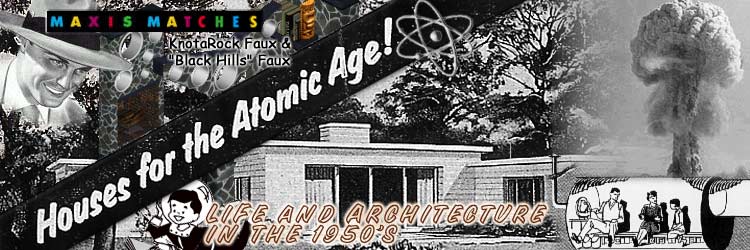
It doesn't take long in playing The Sims before one realises that there are very few default build mode items which match the excellent Maxis default exterior brick walls - and, puzzling in itself, very few default floors. In the series "Maxis Matches", you will find several building items retextured from some of the Maxis wall textures to bring a little harmony into your homes. Not all of these items will be found in build mode; some will be found in buy mode / decorative, but all are architectural in style.
The KnotaRock Faux & Black Hills Maxis Match set
This set is actually based on two walls from Maxis - the KnotaRock Faux and "Black Hills" Faux from one of the later expansion packs. These two walls reminded me so much of the 1950s "googie" terrazzo style, I carried this theme through into the original objects and now have expanded it greatly.


The 1950s saw a dramatic rise in the various uses of concrete, stone, brick, and other exterior materials for texture and colour inside the home, bringing together interior and exterior spaces to form a coherent whole. Architectural features were built into the fabric of the interior walls and new concepts in home heating and lighting meant that interior spaces could be more open-plan than ever before, with divisions being created with half-walls or other sectional dividers which in themselves could play a dual function as perhaps bookcases, plant stands or display cases for the newest trend - achingly fashionable Tiki decorating items.
Not so long ago there was a commercial which asked: "It's the 21st century - where are the flying cars? I was promised flying cars?" where is the rest of it that we were promised back in the 50s and 60s?
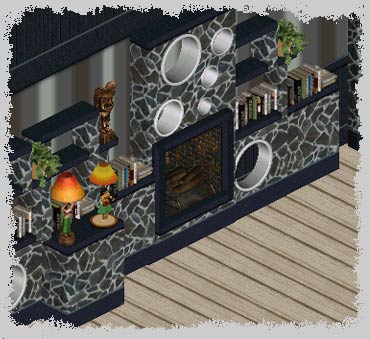
 Four indoor architectural items!
Four indoor architectural items!
This set consists of a "no-fires" animated fireplace, a display shelf with two animated tiki lamps and two bookcases to mix and match in a sectional style.
The fireplace and lamp shelf can only be placed against a wall as they are cloned from the animated wall sconce. Do not place these in a corner as they are slightly larger than one tile to give the appearance of being fully sectional.
 Four Gable Sections and matching roof .bmp file
Four Gable Sections and matching roof .bmp file
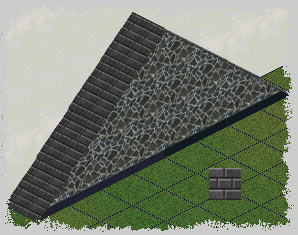
You can place these in any way you like to give the effect of a multi-storey building. Gable roof idea credit to Ophelia at Ophelia's Little Page About The Sims - although I have modified mine somewhat so that they have all four views and can be placed against walls at any rotation. And thanks to Cooptwin, they are droppable so that you won't see them when played with walls cutaway or down. See more of Cooptwin's work at Another #%*& Sim Site
I have to tell you that despite spending hours tweaking the z buffers, these still do bleed a tiny bit in places - and the larger pieces do show quite a few odd pixels here and there especially in the medium zoom. Of course, if you play the game with walls down or cutaway this will make no difference. However, they are much better than they were before, and judicious placement of objects behind the offending pixels will easily mask the bleedthrough.
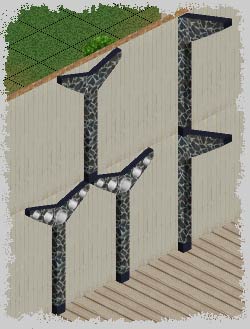
 Three backless & droppable "boomerang" style wall buttresses
Three backless & droppable "boomerang" style wall buttresses
These are decorative items and will not act as pillars. They are all backless and droppable with thanks to Koromo at Persimmon Grove, without whom I simply would not have anything unique to add to this site.
Based on a droppable rug piece, your sims can walk over them, you can put other items on the same tile and HD users can place wall mountable items on the windows as well. I don't recommend placing large items on the same tile, but things like plants & small bushes are ideal. Priced at the astonishingly low bargain basement price of just one simolean, you will find them in Buy Mode / Miscellaneous / General.
The American roadside and occasional urban landscape was once dotted with diners, coffee shops, motels and other buildings utilising boomerang shapes (or "fins"), built in the days when space exploration could capture the attention of millions and optimism about the future was at an all time high.
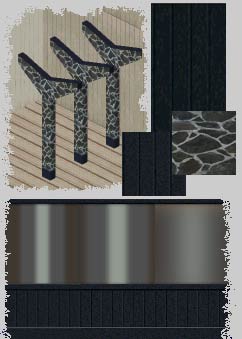
This architectural style, now sometimes known as "Populuxe", "Space Age", "Googie Diner", "Doo-Wop" or even occasionally "Jetsons Style" thrived in the 1950s and early 1960s as commercial architecture designed to make the most of out-of-town shopping centres and other roadside locations. It was often combined with the "Tiki" style which itself borrowed heavily from traditional motifs of cultures of the South Pacific blended with exotic fantasy elements. By the end of the Second World War, the car in the US was not only a symbol of prestige, but it also reflected an era of forward thinking and innovation so it was only natural that buildings meant to attract these car owners to stop driving and shop or dine in them should follow the same thinking and the more exotic or futuristic a building looked, the better.
 Four mix 'n' match wall treatments, two floor treatments, "boomerang" column. This one IS a column, and can be used for supporting upper floors.
Four mix 'n' match wall treatments, two floor treatments, "boomerang" column. This one IS a column, and can be used for supporting upper floors.
This style of architecture fitted the needs of the new American "car culture" and the dreams of the even newer space age perfectly, but sadly, it was widely demolished only a couple of decades later almost as fast as it had been built. It is fair to say that most of the great buildings using the bold angles, colourful signs, sweeping cantilevered roofs and pop-culture imagery from the 50's and 60's have now all but disappeared off the American roadside landscape, and only occasional remnants remain of the wonderment of the mid-century space age.
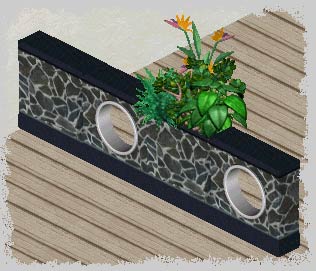
 Three mix 'n' match room dividers
Three mix 'n' match room dividers
The room dividers were retextured and reshaped from an original base at Mermaid Cove . They are cloned from a sculpture, and won't keep the light out of the divided off area - or prevent your sims watching TV in the same room - and the plants will never need watering. One thing to note - Hairfish categorised the original item fully for home, community, downtown and vacation island, but I haven't checked if this categorisation carried through the cloning.
There is some bleed through at certain angles, and the base item statue just refuses to be placed against a wall at one angle. I will review these dividers at some time, but for the meantime these have been updated to remove the fuzzy quality the originals had.
As the 1950s American "Space-Age" style was borne in the a new era of prosperity, optimism and consumerism which emerged during the 1940s, it was a different case in England and the rest of Europe. With little money to spend and severe shortages of petroleum (gasoline) and car manufacturing materials, the few cars that were built were nothing more than basic transportation.
The UK in the 1950s was therefore a very different place from America at that time. Britain was still in a state of post-war austerity, and had only just finished severe rationing in 1948. At the same time, the British post-war government were dedicated to eradicating pre-war social injustice and undertook radical new acts in health, education, welfare and employment that benefitted the common people - which took the whole of the country's meagre resources. While much rebuilding had to be done following the Blitz, the country simply could not afford to do much of what was not essential replacement housing, and indeed many bomb sites were left undeveloped right up until the 1970s.
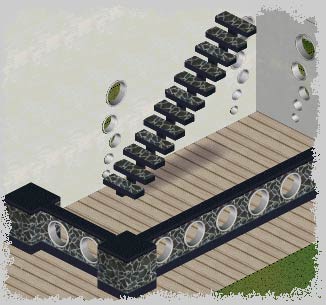
 Staircase, Plain metal window, Boundary connecting fence
Staircase, Plain metal window, Boundary connecting fence
Consequently, the architecture of the 1950s/60s in England (and indeed much of Europe) did not follow the same style, and apart from one or two very notable exceptions, very few buildings were actually built in a modern style until well into the 1960s when economic growth was achieved for the first time in two decades, which in turn was tied to consumer spending, a housing boom and the construction of more motorways following the great success of the M1 opened in November 1959 - the same sweeping social, economic & cultural change which happened in the US twenty years or so earlier.
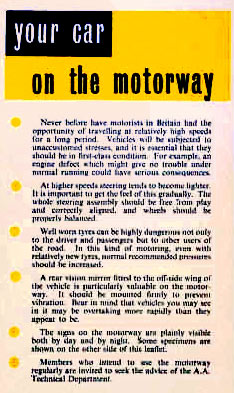
Soon after its opening, the M1 was achieving a rate of 13,000 vehicles each day (today's figure is quoted at over 88,000 for the same stretch of road).
The Automobile Association were concerned about the effects of long distance driving on the British motorist. It is hard for us today to remember that before the war, very few people in the UK had cars and even those were only used regularly for local distances of perhaps 50 miles or thereabouts and perhaps for long distances once a year for the family holiday.
It was therefore decided that special rest stops were to be built for motorists to take frequent breaks, and because there were no urban planning restrictions on the motorways combined with a need for large public buildings to be constructed quickly, our own version of the "Space Age" style was concentrated mainly on these new "Service Stations". On the right is a reproduction of an original leaflet handed to motorists who were nervous about this new form of travelling. (Sorry if it is tricky to read; it is a reproduction of a photograph I took of it in a museum, and tried to make it as clear as I could!)
The new shape of the staircase is based on a real one to be found in one of the last remaining original motorway Service Stations to be found in the UK. Wish I could remember exactly where, but as we were travelling to the North of England I am pretty sure it must be the M1, and pretty sure it wasn't Newport Pagnell, itself a good surviving example of this style. The station I visited is one of the type where you have to cross over the motorway to get to the shops on the others side through a covered bridge and the staircase in question at either end of the bridge is a huge magnificent cantilevered affair, with terrazzo fill on a black marble shell base and is highly unfashionable but thankfully impractical to replace.
Of course, being me, I cloned this smaller imitation from the stone retro staircase, spent ages reshaping, fiddling with all the pieces to get them to fit - and then when testing it in the game I realised that the metal one would have been more or less the correct shape to start with. Ah well, next time I'll know. The stairs do bleed a little when placed next to walls, but this type of staircase was never meant to go against a wall in the first place, so I am happy to leave it as it is.
There are many sites devoted to cataloguing the declining "Space Age" architecural style, and one of my favourites is: Roadside Peek where I was horrified to read of the demolition of the Hawthorne Grill as featured in the famous opening & closing sequences of Quentin Tarantino's masterpiece "Pulp Fiction". I never got to see it and now I never will.
These zips were rescued and have been kept safe by Genie and the fine folks at
N99's Preservation of Bandwidth Society
where they can still be requested, if ever needed.
Installation
Unzip to a temporary storage folder, and you must move the files accordingly as below (this assumes your game is installed on your C: drive's "Program Files" folder):
- Files ending in .wll to C:\Program Files\Maxis\The Sims\GameData\Walls
- Files ending in .flr to C:\Program Files\Maxis\The Sims\GameData\Floors
- Files ending in .iff to C:\Program Files\Maxis\The Sims\GameData\UserObjects
- Files ending in .bmp to C:\Program Files\Maxis\The Sims\GameData\Roofs
Recolouring
If you would like to redesign or recolor objects from this set, please provide credit on your site and in the object description with a link back to us. Most recolours here are from base items from sites participating in the Recolourers Resource Project, but where I have had specific permission for an item to be cloned for this set, you will need to ask the same permissions from the original designer - these are as follows:
-
Base object used in the droppable "boomerang" style wall buttresses by Koromo at Persimmon Grove
All links to the original site where I have made the recolour from are given.



